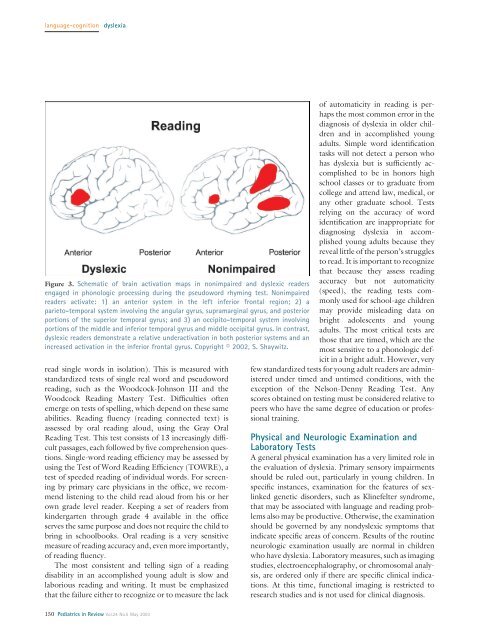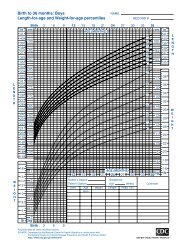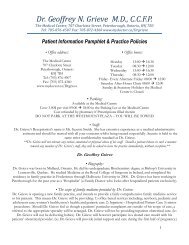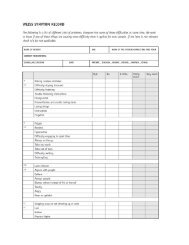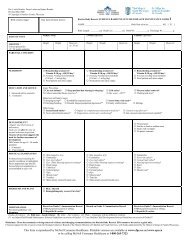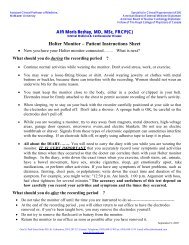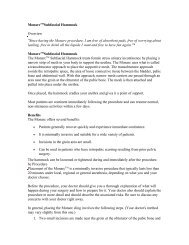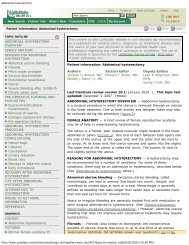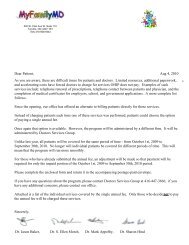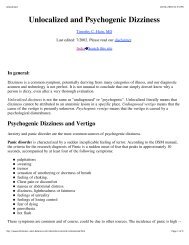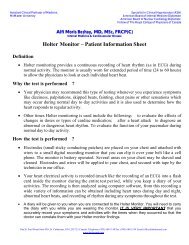Dyslexia (Specific Reading Disability) - Mydoctor.ca
Dyslexia (Specific Reading Disability) - Mydoctor.ca
Dyslexia (Specific Reading Disability) - Mydoctor.ca
Create successful ePaper yourself
Turn your PDF publications into a flip-book with our unique Google optimized e-Paper software.
language-cognitiondyslexiaFigure 3. Schematic of brain activation maps in nonimpaired and dyslexic readersengaged in phonologic processing during the pseudoword rhyming test. Nonimpairedreaders activate: 1) an anterior system in the left inferior frontal region; 2) aparieto-temporal system involving the angular gyrus, supramarginal gyrus, and posteriorportions of the superior temporal gyrus; and 3) an occipito-temporal system involvingportions of the middle and inferior temporal gyrus and middle occipital gyrus. In contrast,dyslexic readers demonstrate a relative underactivation in both posterior systems and anincreased activation in the inferior frontal gyrus. Copyright © 2002, S. Shaywitz.read single words in isolation). This is measured withstandardized tests of single real word and pseudowordreading, such as the Woodcock-Johnson III and theWoodcock <strong>Reading</strong> Mastery Test. Difficulties oftenemerge on tests of spelling, which depend on these sameabilities. <strong>Reading</strong> fluency (reading connected text) isassessed by oral reading aloud, using the Gray Oral<strong>Reading</strong> Test. This test consists of 13 increasingly difficultpassages, each followed by five comprehension questions.Single-word reading efficiency may be assessed byusing the Test of Word <strong>Reading</strong> Efficiency (TOWRE), atest of speeded reading of individual words. For screeningby primary <strong>ca</strong>re physicians in the office, we recommendlistening to the child read aloud from his or herown grade level reader. Keeping a set of readers fromkindergarten through grade 4 available in the officeserves the same purpose and does not require the child tobring in schoolbooks. Oral reading is a very sensitivemeasure of reading accuracy and, even more importantly,of reading fluency.The most consistent and telling sign of a readingdisability in an accomplished young adult is slow andlaborious reading and writing. It must be emphasizedthat the failure either to recognize or to measure the lackof automaticity in reading is perhapsthe most common error in thediagnosis of dyslexia in older childrenand in accomplished youngadults. Simple word identifi<strong>ca</strong>tiontasks will not detect a person whohas dyslexia but is sufficiently accomplishedto be in honors highschool classes or to graduate fromcollege and attend law, medi<strong>ca</strong>l, orany other graduate school. Testsrelying on the accuracy of wordidentifi<strong>ca</strong>tion are inappropriate fordiagnosing dyslexia in accomplishedyoung adults be<strong>ca</strong>use theyreveal little of the person’s strugglesto read. It is important to recognizethat be<strong>ca</strong>use they assess readingaccuracy but not automaticity(speed), the reading tests commonlyused for school-age childrenmay provide misleading data onbright adolescents and youngadults. The most criti<strong>ca</strong>l tests arethose that are timed, which are themost sensitive to a phonologic deficitin a bright adult. However, veryfew standardized tests for young adult readers are administeredunder timed and untimed conditions, with theexception of the Nelson-Denny <strong>Reading</strong> Test. Anyscores obtained on testing must be considered relative topeers who have the same degree of edu<strong>ca</strong>tion or professionaltraining.Physi<strong>ca</strong>l and Neurologic Examination andLaboratory TestsA general physi<strong>ca</strong>l examination has a very limited role inthe evaluation of dyslexia. Primary sensory impairmentsshould be ruled out, particularly in young children. Inspecific instances, examination for the features of sexlinkedgenetic disorders, such as Klinefelter syndrome,that may be associated with language and reading problemsalso may be productive. Otherwise, the examinationshould be governed by any nondyslexic symptoms thatindi<strong>ca</strong>te specific areas of concern. Results of the routineneurologic examination usually are normal in childrenwho have dyslexia. Laboratory measures, such as imagingstudies, electroencephalography, or chromosomal analysis,are ordered only if there are specific clini<strong>ca</strong>l indi<strong>ca</strong>tions.At this time, functional imaging is restricted toresearch studies and is not used for clini<strong>ca</strong>l diagnosis.150 Pediatrics in Review Vol.24 No.5 May 2003


